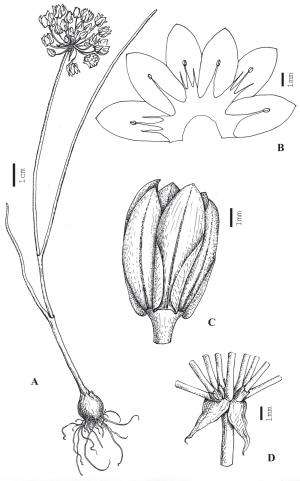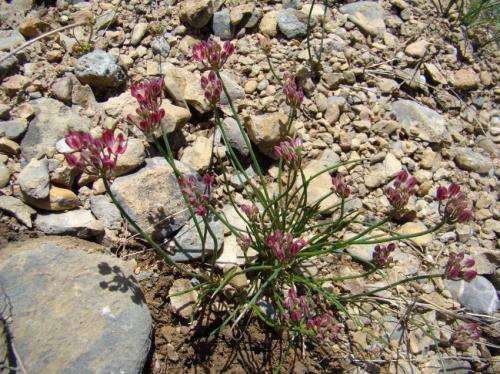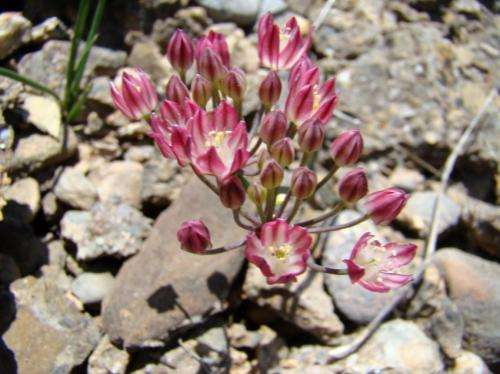Remaining unnoticed for 100 years, a Kyrgyz onion species strikes with its beauty

Situated at the foothills of the Western Tian-Shan, Kyrgyzstan is home to a diverse range of vascular plants, many of which are endemic and can only be found in very narrowly circumscribed areas. Such is the case for the onion species Allium spathulatum that had long remained undetected in spite of living within the famous Sary-Chelek Nature Reserve. Even in close proximity to the headquarters it remained unnoticed until it was finally described in 1998.
The species occurs in the low-altitude forest zone, between 1600 and 1700 m a.s.l., dwelling in river valleys, on open sunny slopes with sparse savanna-type vegetation or sheltered by stones. The plants grow clustered in small patches, suggesting the most successful establishment nearby mature plants. When originally found, the species was considered unique in the subgenus Allium because of its unusual spatule-like bracts subtending pedicels. It probably belongs to an old phylogenetic lineage that has archaic characters and is survived in very few representative species.

A new rare species, Allium formosum, closely related to A. spathulatum, has been now discovered by the scientists Alexander Sennikov from the Finnish Museum of Natural History, University of Helsinki and Georgy Lazkov from the Institute of Biology and Soil Science, National Academy of Sciences in the Kyrgyz Republic, Bishkek. The study was published in the open access journal Phytokeys. The new plant is possibly a very narrow endemic species of the Babash-Ata Mountains, Kyrgyzstan, so far known only from the type locality. The name of the new species is derived from the Latin word for 'beautiful' (formosum) because of its elegant habit and beautiful colouration of the flower, transitional between deeply pink and purple.
The distance between the localities of A. spathulatum and A. formosum, both narrow endemics of mountains surrounding the eastern end of Fergana valley, is about 60 km. The area of the eastern part of the Chatkal Range and the northern outliers of the Fergana Range (Babash-Ata and neighbouring mountains) harbour many other narrow endemics of Allium, and this discovery stresses the need of further explorations and plant protection in this area.

"Because of the vulnerability of the species, we anticipate its inclusion in the forthcoming Red Data Book of Central Asia and the next edition of the Red Data Book of Kyrgyzstan", says the lead author Dr Alexander Sennikov.
More information: Sennikov AN, Lazkov GA (2013) Allium formosum Sennikov & Lazkov (Amaryllidaceae), a new species from Kyrgyzstan. Phytokeys 21: 29, doi: 10.3897/Phytokeys.21.4130
All raw data underpinning this article have been published open access through the Global Biodiversity Information Facility (GBIF) and in the Dryad Data Repository at doi: 10.5061/dryad.pq87t , so that other scientists can verify and build on these records or re-use the data in their studies.
Journal information: PhytoKeys
Provided by Pensoft Publishers












.jpg)







